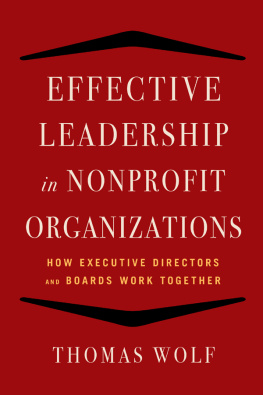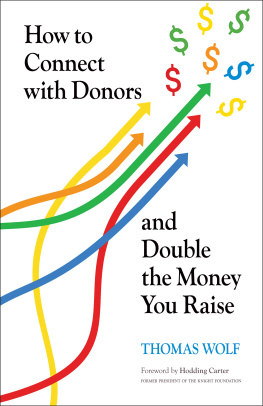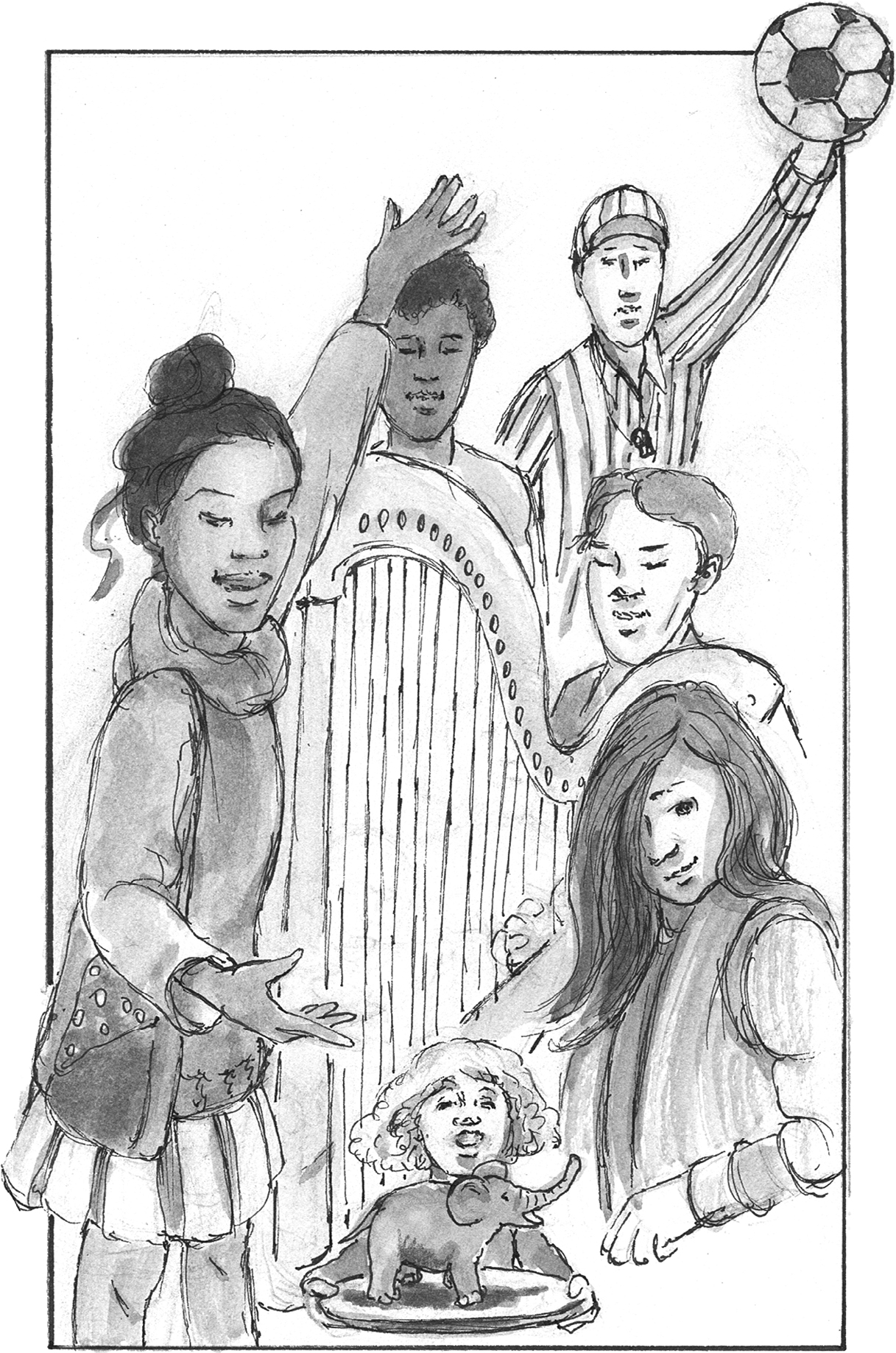Contents
Guide
40th Anniversary Edition
Managing a Nonprofit Organization
Staffing
Fundraising
Recruiting Trustees
Promoting Diversity
Marketing
Budgeting & Accounting
Planning
Managing Crises
Succeeding
Thomas Wolf
Revised and Updated

FREE PRESS
An Imprint of Simon & Schuster, Inc.
1230 Avenue of the Americas
New York, NY 10020
www.SimonandSchuster.com
Copyright 1984, 1990 by Prentice Hall Press
Copyright 1999, 2012, 2022 by Simon & Schuster Inc.
All rights reserved, including the right to reproduce this book or portions thereof in any form whatsoever. For information, address Free Press Subsidiary Rights Department, 1230 Avenue of the Americas, New York, NY 10020.
This Free Press trade paperback edition July 2022
FREE PRESS and colophon are trademarks of Simon & Schuster, Inc.
For information about special discounts for bulk purchases, please contact Simon & Schuster Special Sales at 1-866-506-1949 or .
The Simon & Schuster Speakers Bureau can bring authors to your live event. For more information or to book an event, contact the Simon & Schuster Speakers Bureau at 1-866-248-3049 or visit our website at www.simonspeakers.com.
Interior design by Esther Paradelo
Cover design by Natalia Olbinski
Library of Congress Cataloging-in-Publication Data has been applied for.
ISBN 978-1-9821-5897-2
ISBN 978-1-4391-3489-4 (ebook)
In memory of my parents Irene and Walter Wolf who committed time, money, and children to nonprofit organizations
And to my grandchildren Asa, Sasha, Lyla, Isaiah, and Elias who I hope will continue the tradition
NOTE TO READERS
This publication contains the opinions and ideas of its author. It is sold with the understanding that neither the author nor the publisher is engaged in rendering legal, tax, investment, insurance, financial, accounting, or other professional advice or services. If the reader requires such advice or services, a competent professional should be consulted. Relevant laws vary from state to state. The strategies outlined in this book may not be suitable for every individual or organization, and are not guaranteed or warranted to produce any particular results.
No warranty is made with respect to the accuracy or completeness of the information contained herein, and both the author and the publisher specifically disclaim any responsibility for any liability, loss or risk, personal or otherwise, which is incurred as a consequence, directly or indirectly, of the use and application of any of the contents of this book.
Some names and identifying details of some of the individuals and organizations mentioned in this book have been changed.
PREFACE
PREFACE
This book represents the sixth version of a book originally developed for a course at Harvard University in the early 1980s. I wrote it because no text existed at that time that covered the material I wanted to teach in a fashion that I thought my students required. Most of the students had some experience working in nonprofit organizations, but they were hungry for simple, practical advice. The material was oriented toward challenges and opportunities for staff, board, and other volunteers of smaller nonprofit organizations who were completely unschooled or had learned what they knew on the job. The book contained lots of practical information that anyone working in such an organization could immediately apply.
When a publisher offered to publish the material and a book was issued in the early 1980s under the title The Nonprofit Organization, I was surprised to discover that experienced professionals in larger organizations were buying and using it. Bulk orders were being placed by organizations that were distributing it to trustees and staff. Foundations were purchasing the book and giving it to their grantees. And the book was being used in a growing number of university courses. Thus, a second edition was prepared called Managing a Nonprofit Organization, which dealt with a wider variety of situations and challenges. As the millennium was approaching, I revised the material again in light of what appeared to be emerging issues for the twenty-first century and I expanded the title to Managing a Nonprofit Organization in the Twenty-First Century. That version was updated once again in 2012.
As we reach the fortieth anniversary of the book, I offer yet another version of it. I marvel at how much has changed in the world of nonprofit organizations in four decades. Almost no one had heard of the internet when I first wrote the book, and the World Wide Web was some years in the future. Nor was there widespread focus on such societal issues as income inequality, sexual harassment, or structural racism. People were far more concerned about threats from the Soviet Union, double-digit inflation, and the escalation of gasoline prices than they were about terrorism, climate change, or worldwide pandemics.
Even at the end of the last millennium, as I was preparing a new edition of the book, few predicted the scope of the changes that would be brought on by the cataclysmic events of the early twenty-first century. In the aftermath of the terrorist attacks of September 11, 2001, a fundamental reassessment of the role, governance, and management of nonprofits began and was expanded due to the high-profile failure of several global for-profit companies and the financial meltdown that followed toward the end of the decade.
Other fundamental changes documented over the years and in this edition relate to technology, accountability, sustainability, diversity, leadership, and crisis management:
- In the area of technology, one of the most important developments has been the impact of social media on nonprofitsespecially in the areas of marketing and fundraising. In addition, the internet has become a critical tool for reaching people, sharing information, and delivering products and services. With the advent of a pandemic in 2020, many in the nonprofit world were unable to leave home and had to rely on virtual communication with the outside world. Thanks to technology, they were able to continue serving constituents and managing their nonprofits in ways unimaginable only a decade before.
- The power of the internet broadened my geographic perspective and influenced some of the new material in this book. A few years before I undertook this new edition, I had an opportunity to teach a massive open online course (MOOC). My students, numbering in the tens of thousands, represented over a hundred countries worldwide. I was able to familiarize myself with some of the remarkable work going on in nonprofits around the world as well as the challenges they face. It gave me an appreciation for the extraordinary reach and power of these organizations to make the world a better place. In various countries, these organizations may go by different names (for example, some are called nongovernmental organizations, others charities) and the laws by which they operate vary somewhat from those we are familiar with in the United States. But because their work is important and because they resemble U.S. nonprofits in many respects, I included material in this edition that makes it more relevant to an international readership.


















